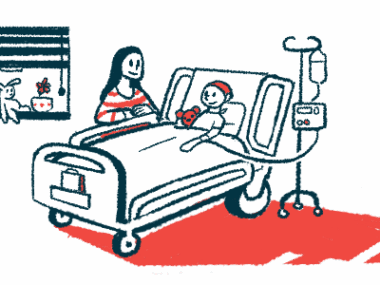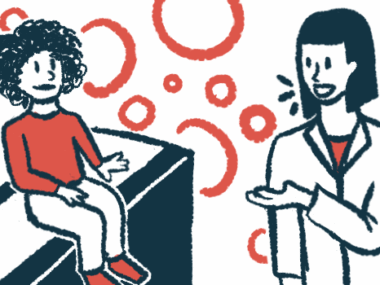Home Monitoring in CF May Help Detect Pulmonary Exacerbations
Written by |

Home monitoring with a mobile phone-linked spirometry device may provide an effective way of detecting pulmonary exacerbations — episodes of a sudden worsening of respiratory symptoms — in people with cystic fibrosis (CF), a pilot study suggests.
The findings showed more pulmonary exacerbations were identified through home monitoring compared with standard CF care, although health-related quality of life and hospitalization results were similar between the study’s two patients groups.
The use of home monitoring was generally well-accepted by patients, for whom it gave a sense of control and independence.
“For many, having an [increased] sense of self-agency was felt to prompt better self-care and help-seeking behaviours,” the researchers wrote, noting that use of such monitoring left patients “feeling more empowered and reassured.”
The study, “A prospective randomised controlled mixed-methods pilot study of home monitoring in adults with cystic fibrosis,” was published in the journal Therapeutic Advances in Respiratory Disease.
People with CF are particularly susceptible to bouts of pulmonary exacerbations and reduced lung function. If these episodes occur too often or go untreated, patients may be at greater risk of developing permanent lung damage.
Several factors have been identified that can predict whether a patient is more likely to fail to return to baseline, or a starting status, after an exacerbation. These include being female, infection with bacteria such as Pseudomonas aeruginosa — common among people with PF — and being malnourished. Another predictive factor is a large decrease, before the start of treatment, in a commonly used measure of lung function called forced expiratory volume in 1 second, or FEV1.
In theory, early diagnosis of exacerbations could reduce or even prevent permanent loss of lung function. According to the researchers, since symptoms often gradually worsen during an exacerbation, home monitoring would allow faster treatment initiation and possibly improve patient outcomes. However, a previous trial, called Early Intervention in Cystic Fibrosis Exacerbation (eICE, NCT01104402) failed to show slower lung function decline with home monitoring.
Despite these findings, researchers in the U.K. hypothesized that home-monitored patients would need fewer days hospitalized and have a better health-related quality of life (HRQoL) compared with patients receiving routine CF care.
In this pilot study (NCT02994706), conducted at West Midlands Adult CF Centre, in Birmingham, adults with CF were randomly assigned to the home monitoring intervention or to standard care. Home-monitored patients were provided with a Bluetooth-enabled digital spirometer and a mobile phone, and instructed to examine their health status twice a week during the yearlong study period. Of note, a spirometer measures the amount of air breathed in and out by the lungs.
Participants were required to record their FEV1 results using the digital spirometer. Their symptoms also were recorded with the use of the Cystic Fibrosis Respiratory Symptom Diary – Chronic Respiratory Infection Symptom Score (CFRSD-CRISS). This 16-question test is intended to identify pulmonary exacerbation symptoms in CF. Measurements were documented at study visits at the study’s start (baseline), and at three, six, nine, and 12 months.
A drop in FEV1 of 10% or more from baseline and/or a total score of the CFRSD-CRISS worsening by more than 10 points automatically triggered an alert to the participant’s care team. The team would then discuss the symptoms with the patient and decide on the best approach.
Secondary outcome goals of the trial included assessments of antibiotic requirements, measured by the number of days on oral and intravenous (in-the-vein) antibiotics, and the identification of protocol-defined pulmonary exacerbations. This was described as the presence of four or more specific criteria, including a change in sputum, increased coughing, increased shortness of breath, fatigue, and fever, and changes in lung function.
A total of 88 patients were enrolled in the study, with 44 receiving home monitoring and 44 routine care. Of note, seven patients withdrew from the home monitoring portion and six from routine care, for reasons such as anxiety and the burden of the study. Two participants in the routine care group died of progressive CF lung disease.
Half of the home-monitored participants sent data at least once per week in more than 80% of their follow-up weeks, according to researchers.
The mean number of hospital inpatient days was similar (approximately 18 days) for patients in the home monitoring intervention group and for those receiving standard care.
To determine HRQoL, the team used the Cystic Fibrosis Questionnaire-Revised (CFQ-R) consisting of 49 self-reported items with 12 domains or areas, such as physical functioning, emotional functioning, and general health perception. No differences in HRQoL were found between the two groups.
Protocol-defined pulmonary exacerbations were detected more often in home-monitored patients during the study period (4.4 vs. 3.8). Participants in the home-monitored group also received oral antibiotics for protocol-defined pulmonary exacerbations for longer compared with patients receiving routine care (51 days vs. 31 days). However, no differences in FEV1 over the 12-month study period were found.
The researchers estimated that the total societal costs (National Health Service and patient perspective) were about £1,650 (about $2,150) more per patient receiving routine care group compared with home-monitored patients, although this difference was not statistically significant.
A qualitative analysis showed that most patients felt that home monitoring was beneficial. “In particular, participants felt that HM [home monitoring] would help them to detect subtle changes in their condition, enabling more responsive and preventive approaches to care,” the scientists wrote.
Overall, such monitoring “provided ‘another tool’ and ‘another piece of the jigsaw’ to positively inform self-care decisions,” the team added.
However, a few patients described feeling “a bit more anxious or a bit more worried’, frustrated or annoyed, especially when results deteriorated,” when using home monitoring.
Researchers suggested that participants in future studies be afforded “more flexibility and choice” in how they used home monitoring. Specifically, some patients wanted more say over the frequency of monitoring — “with once a week being a preferred option,” researchers noted — and the timing of spirometry to make it better fit their schedules.
“The findings of this trial confirm that HM is effective in detecting [pulmonary exacerbations] in adults with CF,” the investigators wrote. “The qualitative results of this study demonstrate that most participants welcomed HM as an intervention for CF and were able to integrate it into their daily lives,” they concluded.








